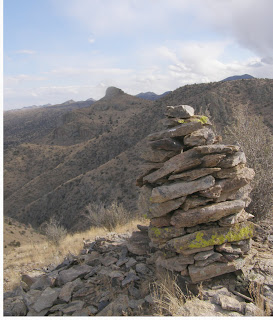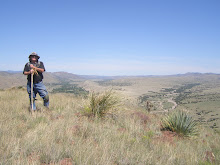Drilling For Berylium At Ojo Caliente
 1. Snowy San Mateo Mountains, from peak above Rio Alamosa. The San Mateos were, of course, sacred to the Chihene N'de.
1. Snowy San Mateo Mountains, from peak above Rio Alamosa. The San Mateos were, of course, sacred to the Chihene N'de. 2. This is a photo taken when Eddy Montoya and I walked with the owner of the Cañada Alamosa Institute on his land, which is along Rio Alamosa.
2. This is a photo taken when Eddy Montoya and I walked with the owner of the Cañada Alamosa Institute on his land, which is along Rio Alamosa.3. This photo (below) shows a "lookout" that I found on one of the peaks near Ojo Caliente. I have reason to believe Victorio himself might have used this place when talking with a cavalry officer who was below, at Ojo Caliente Fort.
 4. This is a photo taken from a stronghold of Victorio's. It looks to the east, northeast, with the San Mateos in the background. Is it any wonder the New York Times reporter wrote about this that with a hundred men, Victorio could hold off an Army?
4. This is a photo taken from a stronghold of Victorio's. It looks to the east, northeast, with the San Mateos in the background. Is it any wonder the New York Times reporter wrote about this that with a hundred men, Victorio could hold off an Army? 5. This is an Apache pictograph in a crevice, or niche in the rock, along Rio Alamosa.
5. This is an Apache pictograph in a crevice, or niche in the rock, along Rio Alamosa.
6. I believe this is a wickiup circle along Rio Alamosa I found three or four years ago.
 All photos are copyright @ Skymindgraphics, property of Jerry Eagan, www.hikingapacheria.com. Please ask for permission to duplicate.
All photos are copyright @ Skymindgraphics, property of Jerry Eagan, www.hikingapacheria.com. Please ask for permission to duplicate.Bill Brancard
Director, Mining and Minerals Division
New Mexico Energy, Minerals and Natural Resources Department
1220 South Saint Francis Drive
Mr. Brancard:
I wish to convey to you some of the reasons why I believe Non-Minimal Impact Exploration Application SO014ER should be denied.
The area we speak of, called by many, Cañada Alamosa, is a very special place for the members of the Chihene N'de (Warm Springs) Apache. And, as a writer and hiker of things Apache, it is a special place for me, too.
The history of the Southwest, is replete with thousands of mining explorations, some profitable and long-lasting, others, "fly by night" operations that have left the land scarred for no good reason when one looks back over the course of our development. Fortunately, other than through over grazing, this area hasn't been damaged to the degree others in my own neighborhood, here in Grant County, have, by mining.
I'd take that as a sign that for unknown reasons, those who have wished to mine minerals from Mother Earth have gone elsewhere. I'd contend that one reason, intangible as it may be, is the desire to not be the first to destroy the pristine nature of Cañada Alamosa.
I came to New Mexico in 2002, and began my own exploration, through literature, and direct experience, of the Chihene N'de homeland, of Cañada Alamosa. Over the years, I've hiked in various places in that area. Apache writers Jason Betzinez and James Kaywakla both wrote of the area, and in particular, the sacred waters of Ojo Caliente, and the lands that surrounded it, and as a reader, I hought: "They write about this place as if it were the 'Garden of Eden.' I must go there, and experience it!"
My first venture to that area was Labor Day weekend, 2002. I wasn't disappointed. Each day, my friend and I bathed in the pool the Apaches bathed in for centuries. Each day we "hiked Apacheria" in the first few miles on both sides of Rio Alamosa, from fort Ojo Caliente, into the "Monticello Box" and several miles downstream. We saw in the river, and on the hills we climbed, remnants of the Apache.
That was a stunning experience. I'd never have guessed that some of the places I'd read about, and would continue to read about in greater depth, were still there, often covered by grass and lichen from many years of silent existence. These "things" are remnants of the semi-nomadic Native Americans who were run off, finally, by our ancestors, Hispanic and Anglo.
The land itself, on both sides of the river, of course, have been claimed by Chihene N'de Apaches and there have been legal settlements of these places in the 20th Century. The proximity of the Red Paint Cave, near where the mining is planned, to my knowledge, is unique in that it has provided the materials from Mother Earth the Chihene painted themselves with, to define themselves as "Red Paint People." In a struggle between the world of spirit, and world of capital, these places may not matter much to folks who think "capital." The land, after all, is the land, and if it holds critical materials the United States needs for whatever reason, shouldn't that matter more?
However, at some point, a nation that claims to be a nation of God, must recognize that certain things should remain untouched. For those who have given more weight to things Spiritual, preservation transcends advancing a moneyed agenda. This concept of leaving special areas untouched and untrammeled, is the heart of our concept of "wilderness areas" ... places where a man can walk for two weeks and never see another human being. America isn't only a place, but is also an idea, of a land of vast open spaces that stirs the heart and mind. While many have wanted to "fill empty places up with things," others have wisely decided to not fill these empty places up, but rather, let them be.
In a world that moves ever faster, then, a single mine, drilled even carefully, won't change our history or wealth. To the Chinene N'de, drilling Mother Earth itself is sacrilege ... an anathema to them. I contend they'd say there's no mineral wealth worth destroying such a place. In this case, there's no public good that transcends despoiling this place where the Chihene N'de's God, Ussen, resides in silence and stillness. If you grant this permit, I'd contend, we will all suffer, spiritually, if we discard such thoughts of preserving some places as "sacred," against the linear logic of harvesting minerals for profit.
To extract these critical materials, won't, in the long term, harm our state, or nation. To claim otherwise is a lie. There's been no mineral that was so critical in one place that it could not have been mined "somewhere else" ... i.e., one empty space to another, but minus the history the Red Paint Cañon has for the Chihene N'de. I ask that, therefore, you deny this claim, and allow this particular place, the Red Paint Cañon, and Cañada Alamosa, to remain untouched.
When this blip of mining activity moves elsewhere, the land, the beautiful, pristine waters of Cañada Alamosa, the plants, the animals, will be there, as they have always been, as a part of the living spirit of Ussen.
We wouldn't take a chain saw to the Olive Garden where Jesus struggled before he was turned over to the Romans for torture and crucifixion. The place where Buddha sat under the Bodhi Tree is venerated, and hasn't been turned into a rice paddy. The Red Paint Cañon is just as special to our Apache brothers and sisters as those places Christian and Buddhist.
I would contend it takes someone special to state:" I denied this application because this place is sacred to the Chihene N'de. Have we not taken enough from these people, over all these years? Can we not now stand to protect such a special place for the Apaches who venerate it?"
This really can be enough of a reason to deny this permit.
I suspect, you, and your fellows, if you make this decision, will never regret taking such a stand. I would offer to you to walk with me, in some of these special places of Cañada Alamosa, and the Red Paint Cañon, so that you can directly experience of what the Apaches have always experienced. While this may not be the Christian Eden, or the Buddhist Bodhi Place, there's no doubt Cañada Alamosa, and the Red Paint Cañon, are the heart of the sacred for the Chihene N'de.
To preserve this place, simply for that reason, will confer upon you a specialness you will never lose, if you make the decision to deny this application for mining and drilling.
Jerry Eagan







